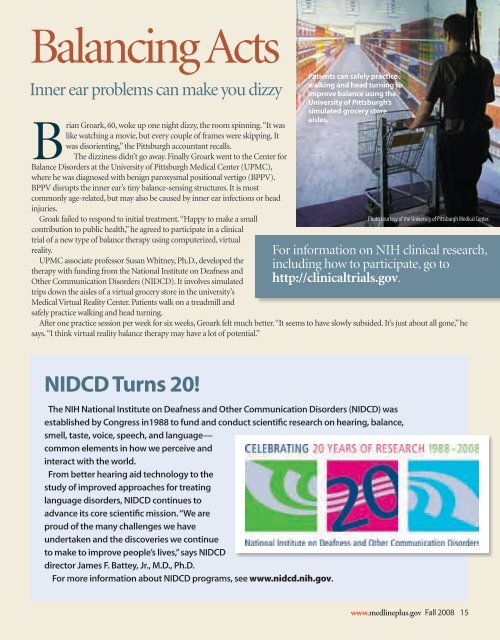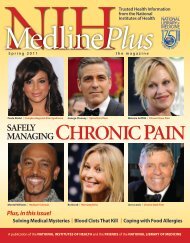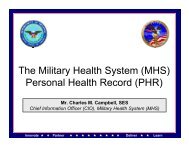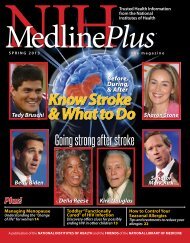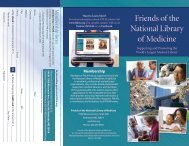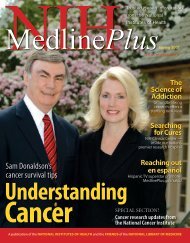Fall 2008 - Friends of the National Library of Medicine
Fall 2008 - Friends of the National Library of Medicine
Fall 2008 - Friends of the National Library of Medicine
You also want an ePaper? Increase the reach of your titles
YUMPU automatically turns print PDFs into web optimized ePapers that Google loves.
Balancing Acts<br />
Inner ear problems can make you dizzy<br />
Brian Groark, 60, woke up one night dizzy, <strong>the</strong> room spinning. “It was<br />
like watching a movie, but every couple <strong>of</strong> frames were skipping. It<br />
was disorienting,” <strong>the</strong> Pittsburgh accountant recalls.<br />
The dizziness didn’t go away. Finally Groark went to <strong>the</strong> Center for<br />
Balance Disorders at <strong>the</strong> University <strong>of</strong> Pittsburgh Medical Center (UPMC),<br />
where he was diagnosed with benign paroxysmal positional vertigo (BPPV).<br />
BPPV disrupts <strong>the</strong> inner ear’s tiny balance-sensing structures. It is most<br />
commonly age-related, but may also be caused by inner ear infections or head<br />
injuries.<br />
Groak failed to respond to initial treatment. “Happy to make a small<br />
contribution to public health,” he agreed to participate in a clinical<br />
trial <strong>of</strong> a new type <strong>of</strong> balance <strong>the</strong>rapy using computerized, virtual<br />
reality.<br />
UPMC associate pr<strong>of</strong>essor Susan Whitney, Ph.D., developed <strong>the</strong><br />
<strong>the</strong>rapy with funding from <strong>the</strong> <strong>National</strong> Institute on Deafness and<br />
O<strong>the</strong>r Communication Disorders (NIDCD). It involves simulated<br />
trips down <strong>the</strong> aisles <strong>of</strong> a virtual grocery store in <strong>the</strong> university’s<br />
Medical Virtual Reality Center. Patients walk on a treadmill and<br />
safely practice walking and head turning.<br />
Patients can safely practice<br />
walking and head turning to<br />
improve balance using <strong>the</strong><br />
University <strong>of</strong> Pittsburgh’s<br />
simulated grocery store<br />
aisles.<br />
Photo courtesy <strong>of</strong> <strong>the</strong> University <strong>of</strong> Pittsburgh Medical Center.<br />
For information on NIH clinical research,<br />
including how to participate, go to<br />
http://clinicaltrials.gov.<br />
After one practice session per week for six weeks, Groark felt much better. “It seems to have slowly subsided. It’s just about all gone,” he<br />
says. “I think virtual reality balance <strong>the</strong>rapy may have a lot <strong>of</strong> potential.”<br />
NIDCD Turns 20!<br />
The NIH <strong>National</strong> Institute on Deafness and O<strong>the</strong>r Communication Disorders (NIDCD) was<br />
established by Congress in1988 to fund and conduct scientific research on hearing, balance,<br />
smell, taste, voice, speech, and language—<br />
common elements in how we perceive and<br />
interact with <strong>the</strong> world.<br />
From better hearing aid technology to <strong>the</strong><br />
study <strong>of</strong> improved approaches for treating<br />
language disorders, NIDCD continues to<br />
advance its core scientific mission. “We are<br />
proud <strong>of</strong> <strong>the</strong> many challenges we have<br />
undertaken and <strong>the</strong> discoveries we continue<br />
to make to improve people’s lives,” says NIDCD<br />
director James F. Battey, Jr., M.D., Ph.D.<br />
For more information about NIDCD programs, see www.nidcd.nih.gov.<br />
www.medlineplus.gov <strong>Fall</strong> <strong>2008</strong> 15


